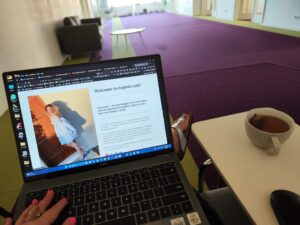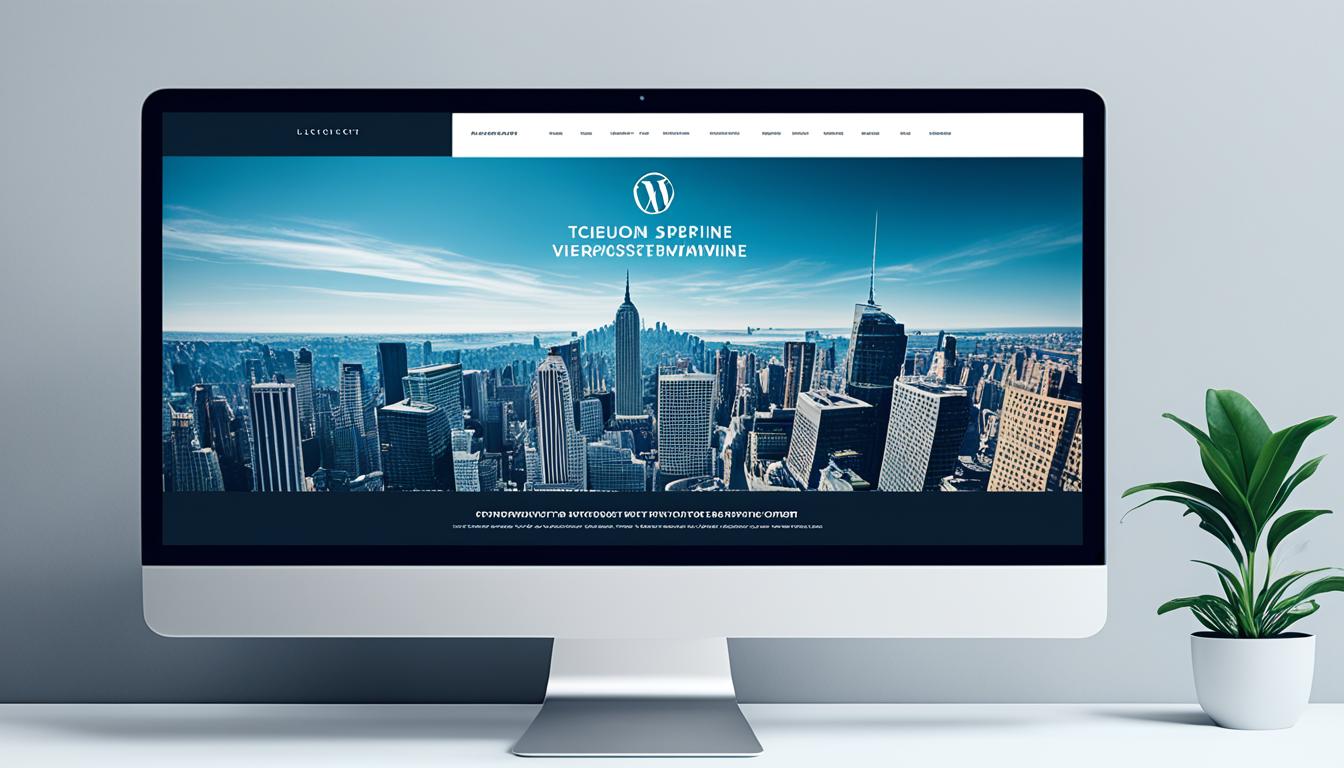Did you know that WordPress is the most popular Content Management System (CMS) in the world, used by approximately 43.2% of all websites?
If you have a PSD (Photoshop Document) file and want to convert it into a fully functional WordPress website, the process can be challenging. However, with the help of professional PSD to WordPress conversion services, you can make this conversion process effortless and seamless.
In this article, we will guide you through the essential steps involved in converting a PSD file to a WordPress theme. From planning and preparation to slicing the design, setting up WordPress, creating templates, adding extras, testing functionality, and optimizing code, we’ll cover everything you need to know to successfully convert your PSD file to a WordPress website.
But before we dive into the details, let’s explore why you should consider converting PSD to WordPress and the benefits it brings to your website.
Essential Steps for Seamless PSD to WordPress Conversion
Before you can convert a PSD file to WordPress, it’s essential to go through a few important steps. These steps will ensure a smooth and successful conversion process. Here’s what you need to do:
Analyze and Plan
The first step is to carefully analyze the PSD design and plan the overall structure and layout of your WordPress website. This involves understanding the design elements, identifying the different sections, and determining how they will translate into the WordPress theme.
Gather Resources
Gather all the necessary resources, including the original PSD files and your WordPress installation. Having these resources readily available will make the conversion process much easier and more efficient.
Slice and Code
Slicing the PSD designs is a crucial step in the conversion process. This involves creating a new HTML file, slicing the PSD design into images, and coding the HTML structure and CSS styles. This step ensures that the design elements are accurately translated into the WordPress theme.
Optimize for WordPress
After slicing and coding the PSD designs, it’s important to optimize the code for WordPress. This includes converting the HTML and CSS files into WordPress templates, integrating dynamic features, and ensuring the code is clean and efficient.
Test and Fine-Tune
Once the conversion is complete, it’s crucial to thoroughly test the WordPress theme for functionality and compatibility. Test the website on different browsers and devices to ensure a seamless user experience. Make any necessary adjustments and fine-tune the theme until it meets your requirements.
| Benefits | PSD to WordPress Conversion |
|---|---|
| Dynamic Content Management | Allows easy updating and management of website content. |
| Customization and Flexibility | Enables you to customize the design and functionality according to your needs. |
| Extensive Plugin Ecosystem | Access a wide range of plugins to enhance your website’s features and functionality. |
| Search Engine Friendliness | Optimized code and SEO-friendly features make it easier for search engines to crawl and index your website. |
Setting Up WordPress
Once you have sliced the PSD designs, the next crucial step is setting up WordPress. This will prepare your website for the conversion process and seamless integration with the HTML/CSS files. Follow these steps to set up WordPress:
- Install WordPress on the web server: Begin by installing WordPress on your web server. You can download the latest version of WordPress from the official website and follow the installation instructions.
- Configure basic settings: After installation, take some time to configure the basic settings of your WordPress website. This includes choosing a site title, setting the time zone, and selecting the desired permalink structure.
- Select a suitable WordPress theme or create a custom one: The appearance of your WordPress website is determined by the theme you choose. Browse through the available themes and select one that aligns with your website’s design and functionality requirements. If you have advanced coding skills, you can also create a custom WordPress theme to match your specific design preferences.
Setting up WordPress is a crucial foundation for the PSD to WordPress conversion process. It ensures a smooth transition from the PSD designs to a fully functional WordPress website. Now that your WordPress installation is complete, you’re ready to move on to the next step: creating WordPress templates.
WordPress Setup Checklist
| Steps | Description |
|---|---|
| 1 | Install WordPress on the web server |
| 2 | Configure basic settings |
| 3 | Select a suitable WordPress theme or create a custom one |
Now that you have WordPress set up, you’re one step closer to converting your PSD designs into a fully functional WordPress website. In the next section, we’ll dive deeper into creating WordPress templates, which will bring your design to life within the WordPress framework.
Creating WordPress Templates
Creating WordPress templates is a crucial step in the PSD to WordPress theme conversion process. It involves understanding the WordPress template hierarchy, transforming sliced HTML/CSS files into WP templates, and implementing dynamic features using WordPress features. This allows for easy management and updating of site content without affecting the overall design and layout.
When converting HTML/CSS files into WordPress templates, it’s important to follow the WordPress template hierarchy. This hierarchy determines the order in which different template files are used to display various types of content, such as pages, blog posts, archives, and more. By organizing your template files according to the hierarchy, you ensure that each type of content is displayed correctly and consistently.
To transform sliced HTML/CSS files into WordPress templates, you’ll need to break down the design into different components and convert them into PHP code. This includes extracting the header, footer, sidebar, and other elements and converting them into reusable template parts. You can then include these template parts in your WordPress templates to maintain consistency throughout your website.
Implementing dynamic features using WordPress features is another important aspect of creating WordPress templates. WordPress provides a range of built-in functions, template tags, and plugins that allow you to dynamically display content, such as post titles, excerpts, featured images, and more. By utilizing these features, you can make your templates more flexible and customizable.
Overall, creating WordPress templates is a crucial step in the PSD to WordPress conversion process. It ensures that your website is built on a solid foundation, with well-organized template files and dynamic features. This allows for easy management and updating of site content, while maintaining the desired design and layout.
Added Extras
In this step of the PSD to WordPress conversion process, you have the opportunity to add extra features that will elevate the functionality and visual appeal of your WordPress template. By integrating useful plugins and incorporating unique features and interactive elements, you can enhance the overall user experience and make your website stand out.
To enhance functionality and streamline user interaction, consider incorporating features such as:
- Social media integration
- Custom contact forms
- Image galleries or sliders
- E-commerce functionality
- Video or audio players
By carefully selecting and implementing these added extras, you can create a website that not only performs impeccably but also engages visitors and keeps them coming back for more.
Examples of Added Extras
Let’s take a look at some examples of how added extras can enhance the functionality and visual appeal of your WordPress template:
| Added Extra | Description |
|---|---|
| Efficient code implementation that optimizes website performance and functionality. | |
| A professionally designed and visually appealing template that matches your branding and engages visitors. |
These are just a few examples of the added extras you can consider during the PSD to WordPress conversion process. By carefully selecting and implementing the right features for your website, you can create a WordPress template that not only meets your needs but exceeds your expectations.
Functionality and Testing
Ensuring the functionality and compatibility of the website is crucial. This step involves testing the website on different browsers and devices, checking for compatibility and adding any missing functionality. It is important to ensure optimal performance and a seamless user experience.
When converting Photoshop designs to WordPress templates, it is essential to thoroughly test the functionality of the website. This includes checking if all the interactive elements, such as buttons, forms, and menus, work as intended. Testing on various browsers, including Chrome, Firefox, and Safari, ensures that the website functions correctly across different platforms.
Additionally, testing the website on different devices, such as desktop computers, laptops, tablets, and smartphones, is essential to ensure a responsive design. With the increasing number of mobile users, it is crucial that the website adapts and displays properly on smaller screens or in portrait mode.
Analyze the website’s performance by testing its loading speed. Slow-loading websites can lead to higher bounce rates and lower user engagement. Optimize the website’s code and assets, such as images and scripts, to improve its loading time.
Conduct thorough testing of all functionalities, including contact forms, search features, and any custom elements specific to the website. This ensures that users can interact seamlessly with your website, allowing them to navigate, submit forms, and access content without any issues.
During the testing phase, it is crucial to identify and address any bugs, errors, or compatibility issues that may arise. Use debugging tools to track down and fix any issues, making sure that the website functions smoothly across different browsers and devices.
Once all the necessary tests have been conducted and any issues have been addressed, it is time to finalize the website for launch. Ensure that all the features are functioning correctly, the design is visually appealing, and the user experience is seamless.
By thoroughly testing the functionality and compatibility of the website, you can ensure that it provides a smooth and engaging experience for your visitors.
Benefits to Convert PSD to WordPress Theme
If you are considering converting your PSD file to a WordPress template, you are in for a treat. The process brings numerous benefits that can significantly enhance your website’s functionality, design, and overall performance.
Dynamic Content Management
By converting your PSD design to WordPress, you gain access to a powerful content management system. WordPress allows you to easily add, edit, and manage your website’s content, providing a dynamic and user-friendly experience for both you and your visitors.
Customization and Flexibility
A converted PSD to WordPress website offers unparalleled customization options. You have complete control over the look and feel of your site, allowing you to create a unique and tailored online presence. From choosing themes and templates to customizing layouts and colors, the possibilities are endless.
Extensive Plugin Ecosystem
WordPress boasts a vast library of plugins that extend the functionality of your website. These plugins cover a wide range of features, including e-commerce, SEO optimization, social media integration, and more. With just a few clicks, you can enhance your site’s capabilities without the need for extensive coding.
Search Engine Friendliness
Converting PSD to WordPress coding ensures that your website is optimized for search engines. WordPress follows best practices for SEO, making it easier for search engines to crawl, index, and rank your site. This can lead to increased visibility, organic traffic, and better search engine rankings.
But the benefits don’t stop there. When you convert PSD to WordPress, you also gain:
- A responsive and mobile-friendly design, ensuring your site looks great on any device
- Scalability, allowing your website to grow alongside your business
- Future updates and improvements, as WordPress is constantly evolving
- Access to a vibrant community of WordPress users and developers, providing support and resources
Converting your PSD file to a WordPress template is a smart move that offers a wide range of advantages. From easy content management and customization to improved search engine visibility, it’s a step towards creating a powerful and engaging online presence.
| Benefits of Converting PSD to WordPress |
|---|
| Dynamic content management |
| Customization and flexibility |
| Extensive plugin ecosystem |
| Search engine friendliness |
| Responsive and mobile-friendly design |
| Scalability |
| Future updates and improvements |
| Community support and resources |
Conclusion
Converting a PSD file to WordPress may seem like a daunting task, but with the assistance of a professional PSD to WordPress conversion service provider, the process becomes much simpler. By following the essential steps of careful planning, slicing the PSD designs, setting up WordPress, creating WordPress templates, adding desired extras, testing functionality, and optimizing the code, you can achieve a seamless conversion.
The benefits of converting your PSD design to WordPress are numerous. With dynamic content management capabilities, you have the power to easily update and manage your website’s content. The customization and flexibility offered by WordPress themes allow you to create a unique and tailored website. The extensive plugin ecosystem opens up a world of additional features and functionalities for your site.
Furthermore, converting PSD to WordPress ensures search engine friendliness, making your website more discoverable and ranking higher in search engine results. With a responsive and mobile-friendly design, your site will look great and function flawlessly across all devices. WordPress also offers scalability and easy future updates, so your website can grow and adapt alongside your business needs.
In conclusion, PSD to WordPress conversion is a wise choice for creating a user-friendly and interactive website with endless possibilities. Don’t hesitate to reach out to a reliable PSD to WordPress conversion service provider and embark on your website development journey today.
FAQ
Is converting a PSD file to WordPress challenging?
Yes, converting a PSD file to WordPress can be challenging due to the complexity of the process and the technical skills required. However, hiring a PSD to WordPress conversion service provider can make the process easier and more efficient.
What are the essential steps for seamless PSD to WordPress conversion?
The essential steps for seamless PSD to WordPress conversion include careful planning and preparation, analyzing the PSD design, slicing the PSD designs to extract design elements and code the HTML and CSS structure, setting up WordPress, creating WordPress templates, adding extra features, testing functionality, and optimizing the code for search engines.
How do I set up WordPress for PSD to WordPress conversion?
To set up WordPress for PSD to WordPress conversion, you need to install WordPress on your web server, configure basic settings, and select a suitable WordPress theme or create a custom one. This preparation step ensures a smooth integration with the HTML/CSS files and paves the way for the conversion process.
What are the steps involved in creating WordPress templates?
Creating WordPress templates involves understanding the WordPress template hierarchy, transforming sliced HTML/CSS files into WordPress templates, and implementing dynamic features using WordPress features. This step allows for easy management and updating of site content without affecting the overall design and layout.
Can I add extra features to my converted PSD to WordPress website?
Yes, you can add extra features to your converted PSD to WordPress website. This includes integrating useful plugins and adding unique features and interactive elements to enhance the functionality and visual appeal of the website.
How important is functionality and testing in the conversion process?
Functionality and testing are crucial steps in the PSD to WordPress conversion process. Testing the website on different browsers and devices ensures compatibility and a seamless user experience. It is essential to optimize the code for optimal performance and to check for any missing functionality.
What are the benefits of converting PSD to WordPress?
Converting PSD to WordPress brings several benefits, including dynamic content management, customization and flexibility, an extensive plugin ecosystem, and search engine friendliness. It also provides a responsive and mobile-friendly design, scalability, future updates, and community support and resources.
Is PSD to WordPress conversion a complex task?
Yes, PSD to WordPress conversion is a complex task. However, hiring a professional PSD to WordPress conversion service provider can simplify the process and ensure a seamless website development journey with a user-friendly and interactive design.
Data analytics expert. As an analyst and project manager, I have proven to be a strong leader and team player in maintaining a suitable workspace for workers and industries in the oil and gas sector.
By taking into account various factors, with the assistance of state of the art technologies and the utilization of Big Data Analytics.
This includes considering various aspects like volume, velocity, variety, veracity, value together with complexity.
With the recent advent of data recording sensors in exploration, drilling, and production operations, oil and gas industry has become a massive data intensive industry.






